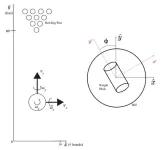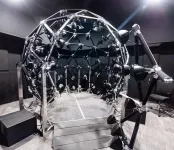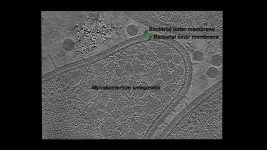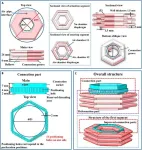(Press-News.org) WASHINGTON, April 15, 2025 – With millions of dollars at stake across tournaments and more than 45 million regular annual participants, bowling continues to reign as a top sport in the U.S. A unified model that predicts how a bowling ball behaves down the lane, however, remains elusive.
In AIP Advances, by AIP Publishing, researchers from Princeton, MIT, the University of New Mexico, Loughborough University, and Swarthmore College share a model that identifies the optimal location for bowling ball placement. Employing a system of six differential equations derived from Euler’s equations for a rotating rigid body, their model creates a plot that shows the best conditions for a strike.
“The simulation model we created could become a useful tool for players, coaches, equipment companies and tournament designers,” said author Curtis Hooper. “The ability to accurately predict ball trajectories could lead to the discoveries of new strategies and equipment designs.”
To date, most methods for predicting the outcome of bowling shots have relied on statistics describing real-life bowlers, rather than analyzing the dynamics of the ball and shot itself. Such approaches have often come short when players introduce slight variability in how they bowl.
Instead, the group’s model accounts for a variety factors. One example is the thin layer of oil applied to bowling lanes; the oil layer can vary widely in volume and shape between competitive tournaments, requiring specific styles and targeting strategies for each. The oil is seldom applied uniformly, which creates an uneven friction surface.
The issue is that bowlers and coaches can currently only rely on their own experience and instinct, which Hooper said is often imprecise and suboptimal.
“Our model provides a solution to both of these problems by constructing a bowling model that accurately computes bowling trajectories when given inputs for all significant factors that may affect ball motion,” Hooper said. “A ‘miss-room’ is also calculated to account for human inaccuracies which allows bowlers to find their own optimal targeting strategy.”
Making the model posed several challenges, including how to describe the motion of the subtly asymmetric bowling ball. More challenging still was distilling the inputs required for predicting the trajectory into terms that a bowler or coach could understand and that could be measured with accessories bowlers already use.
In the future, the group aims to improve the model’s accuracy by incorporating even more factors, including uneven bowling lanes, as well as connect with professionals in the industry to better understand how the model may be tailored to fit their applications.
###
The article “Using physics simulations to find targeting strategies in competitive tenpin bowling” is authored by Simon Si Ming Ji, Shouzhuo Yang, Wilber Dominguez, Curtis George Hooper, and Cacey Stevens Bester. It will appear in AIP Advances on April 15, 2025 (DOI: 10.1063/5.0247761). After that date, it can be accessed at https://doi.org/10.1063/5.0247761.
ABOUT THE JOURNAL
AIP Advances is an open access journal publishing in all areas of physical sciences—applied, theoretical, and experimental. The inclusive scope of AIP Advances makes it an essential outlet for scientists across the physical sciences. See https://pubs.aip.org/aip/adv.
###
END
A bowling revolution: Modeling the perfect conditions for a strike
Conditions from the makeup of the oil on the lane to the subtle asymmetry of a bowling ball can enhance planning for the next strike.
2025-04-15
ELSE PRESS RELEASES FROM THIS DATE:
Simulate sound in 3D at a finer scale than humans can perceive
2025-04-15
WASHINGTON, April 15, 2025 – Surround-sound speakers can immerse you in a multimedia experience, but what if there was a speaker that could completely re-create a three-dimensional soundscape?
The AudioDome is more than just a loudspeaker arrangement — it’s a dome of speakers that can create an immersive sound experience that reproduces sound sources at any location when the listener is placed in the middle.
In JASA, published on behalf of the Acoustical Society of America by AIP Publishing, researchers ...
Screening history, stage at diagnosis, and mortality in screen-detected breast cancer
2025-04-15
About The Study: In this cohort study of older women with screen-detected estrogen receptor–positive or human epidermal growth factor receptor 2–negative breast cancer, prior screening mammography was associated with earlier stage at breast cancer diagnosis and lower breast cancer mortality. These findings support the potential for routine screening to improve breast cancer outcomes. As with all observational studies, this study is limited by the potential effects of other differences between the screening and nonscreening groups.
Corresponding Author: To contact the ...
Pitt researchers release Phage images with unprecedented detail
2025-04-15
Researchers at Pitt have produced the most detailed image to date of a bacteriophage–phage for short–that has allowed them to see for the first time the structural makeup of the part of the phage that directly attaches to its target Mycobacterium cell.
“Now you've got like a spec sheet for going in and designing phages so that they’ll bind to different kinds of cells,” said Graham Hatfull, the Eberly Family Professor of Biotechnology in the Kenneth P. Dietrich School of Arts and Sciences.
That’s important because of what a phage, which is a kind of virus, does after it binds to a bacterial cell: it pierces a hole in the cell membrane and injects ...
Sound wave research for breast cancer receives $5.5 million
2025-04-15
University of Virginia researcher Natasha D. Sheybani, PhD, has received $5.5 million from the federal Department of Defense to support her cutting-edge efforts to use focused sound waves to improve our immune system’s ability to battle breast cancer.
Sheybani, the research director of UVA’s Focused Ultrasound Cancer Immunotherapy Center, was the only scientist in the nation selected to receive a Breast Cancer Research Program Era of Hope Scholar Award in the latest funding round; she is UVA’s first recipient of the award. She will use the grant to advance her research into the potential of focused ultrasound to improve the safety, ...
Gene variant linked to benign prostate hyperplasia risk in Lebanese men
2025-04-15
“Our results indicate a strong association between certain genotypes of the SNP -765 G>C of the PTGS2 gene and BPH.”
BUFFALO, NY – April 15, 2025 – A new research paper was published in Oncotarget, Volume 16, on April 4, 2025, titled “Association between two single nucleotide polymorphisms of the Prostaglandin-Endoperoxide Synthase 1 and 2 genes and cell proliferative prostatic diseases in Lebanon.”
The team of researchers led by first author Brock J. Sheehan and corresponding author Ruhul H. Kuddus, from Utah Valley University, discovered that a specific genetic variation ...
Teoxane announces new study reinforcing the biocompatibility, safety and efficacy of RHA®4 in dynamic facial support
2025-04-15
Teoxane reinforces its commitment to scientific innovation with the publication of a new study in Plastic and Reconstructive Surgery – Global Open, providing robust preclinical and clinical evidence on the safety, biocompatibility, and performance of RHA®4* in midface augmentation.
The study confirms that RHA®4[1], a resilient hyaluronic acid filler designed for dynamic facial areas[2],[3], integrates harmoniously within subcutaneous adipose tissue, preserving its natural biomechanics while delivering effective volume restoration. ...
Study identifies U.S. hotspots for drinking water quality violations and lack of access to safe, clean water
2025-04-15
Herndon, VA, March 25, 2025 -- About two million people in the United States lack access to running water or indoor plumbing in their homes. Another 30 million people live where drinking water systems violate safety rules. Water privatization -- the transfer of public water systems ownership and/or management to private companies -- has been proposed as a potential solution to provide more Americans with safe, clean drinking water. But opponents argue that private companies may prioritize profits over public needs.
To investigate how ...
Busted! Researchers revolutionize fraud detection with machine learning
2025-04-15
Fraud is widespread in the United States and increasingly driven by technology. For example, 93% of credit card fraud now involves remote account access, not physical theft. In 2023, fraud losses surpassed $10 billion for the first time. The financial toll is staggering: credit card fraud costs $5 billion annually, affecting 60% of U.S. cardholders, while identity theft resulted in $16.4 billion in losses in 2021. Medicare fraud costs $60 billion each year, and government losses range from $233 billion to $521 billion annually, with improper payments totaling $2.7 trillion since 2003.
Machine learning plays a critical ...
Earthworm-inspired multimodal pneumatic continuous soft robot enhanced by winding transmission
2025-04-15
A research paper by scientists at Tianjin University presented an earthworm-inspired multimodal pneumatic continuous soft robot enhanced by wire-winding transmission.
The research paper, published on Mar. 19, 2025 in the journal Cyborg and Bionic Systems, proposes an earthworm-inspired multimodal pneumatic continuous soft robot to simultaneously achieve multimodal motion and good motion performance. Using the derived overlapped continuous control law (DOCCL) and wire-winding transmission, the robot can achieve a maximum planar crawling speed that surpasses that of other robots of the same type by an order of magnitude.
With ...
Coastal heritage threatened by climate change
2025-04-15
Humans have always lived by coasts and waterways, and thus these locations are rich with archeological sites. Natural and cultural resource management are conducted separately, despite the fact that climate change, sea level rise, and extreme weather threaten them both. Jayur Mehta and colleagues argue a synergy of both approaches is required to protect coastal archaeological landscapes. The authors used LiDAR digital elevation models, site location data, and NOAA sea level rise models to define ...
LAST 30 PRESS RELEASES:
Tracing the quick synthesis of an industrially important catalyst
New software sheds light on cancer’s hidden genetic networks
UT Health San Antonio awarded $3 million in CPRIT grants to bolster cancer research and prevention efforts in South Texas
Third symposium spotlights global challenge of new contaminants in China’s fight against pollution
From straw to soil harmony: International team reveals how biochar supercharges carbon-smart farming
Myeloma: How AI is redrawing the map of cancer care
Manhattan E. Charurat, Ph.D., MHS invested as the Homer and Martha Gudelsky Distinguished Professor in Medicine at the University of Maryland School of Medicine
Insilico Medicine’s Pharma.AI Q4 Winter Launch Recap: Revolutionizing drug discovery with cutting-edge AI innovations, accelerating the path to pharmaceutical superintelligence
Nanoplastics have diet-dependent impacts on digestive system health
Brain neuron death occurs throughout life and increases with age, a natural human protein drug may halt neuron death in Alzheimer’s disease
SPIE and CLP announce the recipients of the 2025 Advanced Photonics Young Innovator Award
Lessons from the Caldor Fire’s Christmas Valley ‘Miracle’
Ant societies rose by trading individual protection for collective power
Research reveals how ancient viral DNA shapes early embryonic development
A molecular gatekeeper that controls protein synthesis
New ‘cloaking device’ concept to shield sensitive tech from magnetic fields
Researchers show impact of mountain building and climate change on alpine biodiversity
Study models the transition from Neanderthals to modern humans in Europe
University of Phoenix College of Doctoral Studies releases white paper on AI-driven skilling to reduce burnout and restore worker autonomy
AIs fail at the game of visual “telephone”
The levers for a sustainable food system
Potential changes in US homelessness by ending federal support for housing first programs
Vulnerability of large language models to prompt injection when providing medical advice
Researchers develop new system for high-energy-density, long-life, multi-electron transfer bromine-based flow batteries
Ending federal support for housing first programs could increase U.S. homelessness by 5% in one year, new JAMA study finds
New research uncovers molecular ‘safety switch’ shielding cancers from immune attack
Bacteria resisting viral infection can still sink carbon to ocean floor
Younger biological age may increase depression risk in older women during COVID-19
Bharat Innovates 2026 National Basecamp Showcases India’s Most Promising Deep-Tech Ventures
Here’s what determines whether your income level rises or falls
[Press-News.org] A bowling revolution: Modeling the perfect conditions for a strikeConditions from the makeup of the oil on the lane to the subtle asymmetry of a bowling ball can enhance planning for the next strike.







